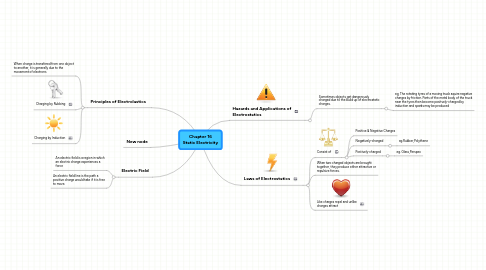Chapter 16 Static Electricity
da Foong Joschin


1. Principles of Electrolastics
1.1. When charge is transfered from one object to another, it is generally due to the movement of electrons
1.2. Charging by Rubbing
1.3. Charging by Induction
2. Electric Field
2.1. An electric field is a region in which an electric charge experiences a force
2.2. An electric field line is the path a positive charge would take if it is free to move.
3. New node
4. Laws of Electrostatics
4.1. Consist of
4.1.1. Positive & Negative Charges
4.1.2. Negatively-charged
4.1.2.1. eg.Rubber,Polythene
4.1.3. Postively-charged
4.1.3.1. eg. Glass,Perspex
4.2. When two charged objects are brought together, they produce either attractive or repulsive forces.
4.3. Like charges repel and unlike charges attract
5. Hazards and Applications of Electrostatics
5.1. Sometimes objects get dangerously charged due to the build up of electrostatic charges.
5.1.1. eg, The rotating tyres of a moving truck aquire negative charges by friction. Parts of the metal body of the truck near the tyres then become positvely-charged by induction and sparks may be produced
